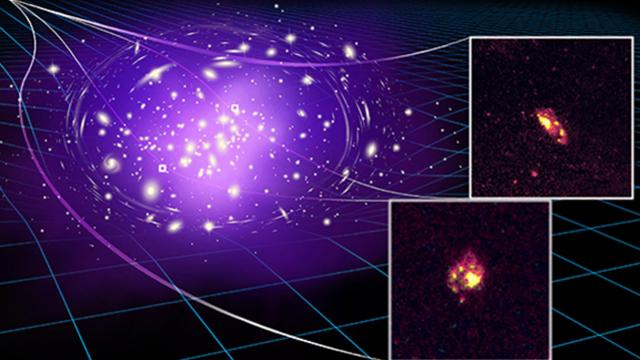What you’re looking at here is the 11 billion year old spiral galaxy A1689B11. It sits behind a massive galaxy cluster that acts like a lens for the light coming from A1689B11 – and this makes two highly magnified images.
So, of course, Australian scientists are studying these images for clues about exactly how galaxies turn from chaotic primitive formations to flat, relatively tranquil ones – like the Milky way.
A1689B11 is the most ancient spiral galaxy discovered to date, and the team of astronomers at Swinburne University of Technology and The Australian National University, which are part of the Australian Research Council Centre of Excellence in All Sky Astrophysics in 3D, are excited by what it may reveal.
Using a technique that combines gravitational lensing with the Near-infrared Integral Field Spectrograph on the Gemini North telescope in Hawaii, researchers verified the vintage and spiral nature of this galaxy. NIFS is Australia’s first Gemini instrument that was designed and built by the late Peter McGregor at the ANU.
“Gravitational lenses are Nature’s largest telescopes, created by massive clusters composed of thousands of galaxies and dark matter,” the researchers explain.
“The cluster bends and magnifies the light of galaxies behind it in a manner similar to an ordinary lens, but on a much larger scale.”
Swinburne astronomer Dr Tiantian Yuan, who led the research team, says this technique allows us to study ancient galaxies in high resolution with unprecedented detail.
“We are able to look 11 billion years back in time and directly witness the formation of the first, primitive spiral arms of a galaxy,” Dr Yuan says.
And the study shows some surprising features of A1689B11 – like the fact that it is forming stars 20 times faster than galaxies today– as fast as other young galaxies of similar masses in the early Universe.
“However, unlike other galaxies of the same epoch, A1689B11 has a very cool and thin disc, rotating calmly with surprisingly little turbulence,” Dr Yuan says.
“This type of spiral galaxy has never been seen before at this early epoch of the Universe!”
This research is an international collaboration including astrophysicists from the University of Lyon in France, Princeton University in the USA and Hebrew University in Israel.
[Source]
